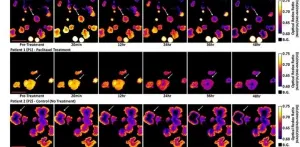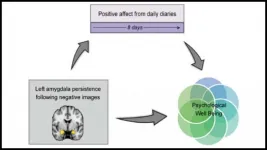Redox imaging allows measurement of drug responses in lab-grown cancer samples
Scientists have developed a nondestructive way of measuring drug treatment responses in lab-grown cancer samples
2021-03-22
(Press-News.org) Organoids are tiny three-dimensional cellular assemblies that are grown in a laboratory from tissue-specific cells. They are particularly interesting to biologists because of their ability to mimic the characteristics of the original tissues. If scientists extract cells from a tumor, then they can grow cancer organoids that mimic the characteristics of the source tumor.
This possibility for individual-level studies of tumor properties makes cancer organoids an exciting tool from the perspective of an emerging field called precision cancer medicine. Daniel Gil of the University of Wisconsin (UW) and Morgridge Institute for Research explains, "Precision cancer medicine is this idea that we can use data to identify better treatments for each patient, and a particularly powerful approach is to use patient-derived cancer organoids, essentially 'tumors-in-a-dish,' to test drugs before giving them to a patient." Gil notes that a key prerequisite for realizing this idea is finding a way to determine whether or not the organoids are responding to a treatment. Existing methods for making this determination provide limited information about drug effects or require destroying the organoids.
A research team including Gil, and directed by Melissa Skala of the Morgridge Institute for Research, therefore aimed to develop an informative, nondestructive way of imaging cancer organoid responses to drug treatments. The researchers chose to focus on an optical imaging technique called redox imaging, which relies on fluorescent signals from metabolites in patient-derived cancer organoids. The researchers hoped to find a set of fluorescent signals readable with redox imaging that would provide insights into the size, shape, and function of each organoid. By analyzing how drug treatments affected such signals, they aimed to develop a screening tool for assessing organoid responses to drug treatments. Their findings are published in the Journal of Biomedical Optics.
For their experiments, the researchers used redox imaging to record signals from two metabolites, called NAD(P)H and FAD, in two separate colorectal cancer organoid lines over a period of 48 hours after drug treatment. As expected, drugs known to kill cancer cells measurably altered the redox signals from the metabolites in ways that suggested a reduction in cell growth rates. The researchers noted that tracking response within a single organoid provided more sensitive information about drug responsiveness than pooled analyses across all organoids in a dish.
Further, redox imaging data analysis allowed the researchers to identify organoid subpopulations that responded to drug treatments in distinct ways. This finding aligns with what scientists know about the heterogeneity of cells within tumors. Gil explains, "Tumors aren't made up of a single cell type, but rather many cell types that often have differing drug sensitivities." He also noted that this heterogeneity can complicate the task of identifying the optimal treatment for a tumor, but the ability of patient-derived cancer organoids to capture tumoral cell heterogeneity may help scientists and clinicians learn to overcome such complications.
This study shows that redox imaging enables nondestructive measurement of drug responses in patient-derived cancer organoids. Gil notes that this approach is well-suited to evaluating large populations of organoids because it's fast and informative. "Redox imaging is a valuable tool that will allow researchers to observe the dynamic nature of drug responses over time," says Gil. Skala remarks, "This is an important step to bring this technology to the clinic in a usable, cost effective way. We hope this can guide treatment choices for more patients."
INFORMATION:
Read the open access research article by D.A. Gil, D. Deming, and M.C. Skala, "Patient-derived cancer organoid tracking with widefield one-photon redox imaging to assess treatment response," J. Biomed. Opt. 26(3), 036005 (2021), doi 10.1117/1.JBO.26.3.036005.
[Attachments] See images for this press release:

ELSE PRESS RELEASES FROM THIS DATE:
2021-03-22
CLEVELAND--A new technique for sampling and testing cells from Barrett's esophagus (BE) patients could result in earlier and easier identification of patients whose disease has progressed toward cancer or whose disease is at high risk of progressing toward cancer, according to a collaborative study by investigators at Case Western Reserve University and Johns Hopkins Kimmel Cancer Center (JHKCC).
Published in the journal Gastroenterology, the findings show the combination of esophageal "brushing" with a massively parallel sequencing method can provide an accurate assessment of the ...
2021-03-22
For something we spend one-third of our lives doing, we still understand remarkably little about how sleep works -- for example, why can some people sleep deeply through any disturbance, while others regularly toss and turn for hours each night? And why do we all seem to need a different amount of sleep to feel rested?
For decades, scientists have looked to the behavior of the brain's neurons to understand the nature of slumber. Now, though, researchers at UC San Francisco have confirmed that a different type of brain cell that has received far less study -- astrocytes, named for their star-like shape -- can influence how long and how deeply animals sleep. The findings could open new avenues for exploring sleep disorder therapies and help scientists better understand brain diseases linked ...
2021-03-22
A large study of brain MRI scans from 11,679 nine- and ten-year-old children reviewed by UC San Francisco neuroradiologists identified potentially life-threatening conditions in 1 in 500 children, and more minor but possibly clinically significant brain abnormalities in 1 out of 25 children.
The results provide the best estimates to date of the true incidence of various structural abnormalities in the developing brain, and raise the question of whether all MRI brain imaging obtained during research studies should be reviewed by board-certified radiologists, as was done in this study, in the hopes of saving lives and alerting participants to incidental findings that ought to be medically evaluated.
One ...
2021-03-22
How the amygdala responds to viewing negative and subsequent neutral stimuli may impact our daily mood, according to new research published in JNeurosci.
The amygdala evaluates the environment to find potential threats. If a threat does appear, the amygdala can stay active and respond to new stimuli like they are threatening too. This is helpful when you are in a dangerous situation, but less so when spilling your coffee in the morning keeps you on edge for the rest of the day.
In a recent study, Puccetti et al. examined data collected from the "Midlife ...
2021-03-22
MINNEAPOLIS/ST.PAUL (03/22/2021) -- New research from the University of Minnesota Medical School suggests that disease-driving B cells, a white blood cell, play a role in the development of non-alcoholic fatty liver disease (NAFLD) - the most common chronic liver condition in the U.S. Their findings could lead to targeted therapies for NAFLD, which currently affects a quarter of the nation and has no FDA-approved treatments.
After noticing that patients with the disease showed a large number of inflammatory B cells in their livers, Xavier Revelo, PhD, an assistant professor in the Department of Integrative Biology and Physiology and senior author, began studying B cells in NAFLD.
"This disease is increasing in prevalence ...
2021-03-22
Although Tuberculosis, or TB, killed nearly as many people as COVID-19 (approx. 1.8 million) in 2020, it did not receive as much media and public attention. The pandemic has proven that transmissible infection is indeed a global issue. TB remains a serious public health concern in Ireland, particularly with the presence of multi-drug resistant types and the numbers of complex cases here continuing to rise, with cases numbering over 300 annually.
Science tells us that iron is crucial for daily human function, but it is also an essential element for the survival of ...
2021-03-22
Batteries charge and recharge--apparently all thanks to a perfect interplay of electrode material and electrolyte. However, for ideal battery function, the solid electrolyte interphase (SEI) plays a crucial role. Materials scientists have now studied nucleation and growth of this layer in atomic detail. According to the study published in the journal Angewandte Chemie, the properties of anions and solvent molecules need to be well balanced.
In lithium-ion batteries, the SEI forms at the beginning of the first charging process, when a potential is applied. Elements from the electrolyte deposit on the graphite electrode and form a coating that soon ...
2021-03-22
Antibiotics have revolutionized the field of medicine by making it possible to treat most known microbial diseases today. However, their uncontrolled usage has led to the major global problem of antibiotic resistance. As we continue to exploit antibiotics, sometimes at doses much higher than needed, disease-causing bacteria are rapidly evolving defense strategies to evade them. These drug-resistant bacteria, also known as "superbugs," cause severe infections that are difficult to treat and can eventually be fatal.
Methicillin-resistant Staphylococcus aureus (MRSA), a particularly vicious group of superbugs that have developed resistance to the antibiotic methicillin, is a major cause of hospital-acquired infections. Accurate and timely diagnosis ...
2021-03-22
Boulder, Colo., USA: Beneath the cold, dark depths of the Arctic ocean sit vast reserves of methane. These stores rest in a delicate balance, stable as a solid called methane hydrates, at very specific pressures and temperatures. If that balance gets tipped, the methane can get released into the water above and eventually make its way to the atmosphere. In its gaseous form, methane is one of the most potent greenhouse gases, warming the Earth about 30 times more efficiently than carbon dioxide. Understanding possible sources of atmospheric methane is critical for accurately predicting future climate change.
In the Arctic Ocean today, ice sheets exert pressure on the ground below them. That pressure diffuses ...
2021-03-22
Screenings for breast cancer and colon cancer dropped dramatically during the early months of the coronavirus pandemic, but use of the procedures returned to near-normal levels by the end of July 2020, according to a new study.
Analyzing insurance claims from more than 6 million Americans with private health coverage, researchers found that mammography rates among women aged 45 to 64 declined by 96% during March and April 2020 as compared to January and February.
Similarly, the weekly rate of colorectal cancer screenings among adults aged 45 to 64 and older declined by 95% during the period.
By the end of July 2020, however, the rate of mammograms among women had rebounded and was slightly higher than it had been before the pandemic was declared. The rate of colonoscopies also rebounded, ...
LAST 30 PRESS RELEASES:
[Press-News.org] Redox imaging allows measurement of drug responses in lab-grown cancer samples
Scientists have developed a nondestructive way of measuring drug treatment responses in lab-grown cancer samples



